|
Those Happy Days
by Bob Brooke
Everyone knows of “Happy Days,” the 1950s-era T.V. sitcom
featuring a typical middle class family. The mother on that show, much
like scores of other American housewives of the period, must have
thought she had died and gone to housewares heaven with the advent of
Melmac dinnerware. That was just one of the items that made her days
truly happy because its durability made it ideal to use in homes with
children.
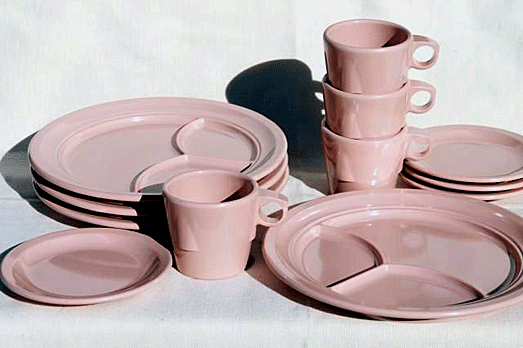
History of Melmac
Initially discovered by William F. Talbot, an employee of American
Cyanamid Corporation in the 1930s, melamine resin or melamine
formaldehyde was a hard, thermosetting plastic material made from
melamine and formaldehyde by polymerization. American Cyanimid nicknamed
it Melmac.
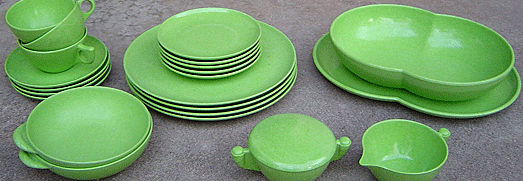
During the 1930's the raw material "melamine" hit an all time low price.
With heightening wartime threats and soon to be monetary constraints,
American industrialists jumped on the bandwagon to make melamine into
functional products for both commercial and household use. By the late
1940s, many factories used it to make dinnerware.
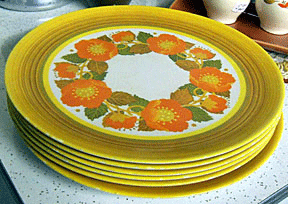 Dishes
made of early plastics and Bakelite didn’t hold up well or withstand
regular washings or heat, but American Cyanimid showed that its new
"improved plastic" could indeed hold up well. While the company produced
the resin, itself, it sold it to other manufacturers which molded it
into dinnerware lines for both home and restaurant use. Dishes
made of early plastics and Bakelite didn’t hold up well or withstand
regular washings or heat, but American Cyanimid showed that its new
"improved plastic" could indeed hold up well. While the company produced
the resin, itself, it sold it to other manufacturers which molded it
into dinnerware lines for both home and restaurant use.
One of the benefits of molders purchasing from American Cyanamid, was
its advertising campaign for Melmac. Old Life magazines from the early
1950's showed Melmac as American Cyanamid’s wonder plastic. There were
other manufacturers who would offer melamine powders for molding. If a
molder were to purchase from a non-Cyanamid distributor, they couldn’t
refer to their melamine dishes as "Melmac." This may be why some old ads
for plastic dinnerware specifically said "Made of Melmac" and others
said just melamine.
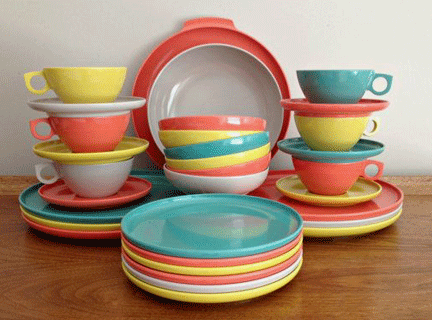 The
actual material "melamine" was dirt cheap in the mid to late 1930's, and
there was a push to use this new material for all kinds of things. The
actual material "melamine" was dirt cheap in the mid to late 1930's, and
there was a push to use this new material for all kinds of things.
Branchell of St. Louis MO made the terrific Color-Flyte and Royale lines
as well as the brightly-colored Aztec line. Of special interest is their
other Kaye LaMoyne design--an Asian design in black and cherry red with
bamboo handles!
Later arrivals to the plastic dinnerware scene are the "space-age"
Heller dinnerware designed by Massimo Vignelli and the stunning Ingrid
(Chicago) dinnerware and drinkware.
Other manufacturers/lines that are of equally high-quality but
apparently weren't distributed as widely include Spaulding Ware, Holiday
and Debonaire by Kenro, Imperial Ware, Mallo-Ware and Watertown. There
are also the terrific mid-century modern melmac lines designed by Russel
Wright, Ben Seibel and Georges Briard. And Royal China Company, Oneida
and Stetson, major pottery companies, also had divisions producing
melamine dinnerware.
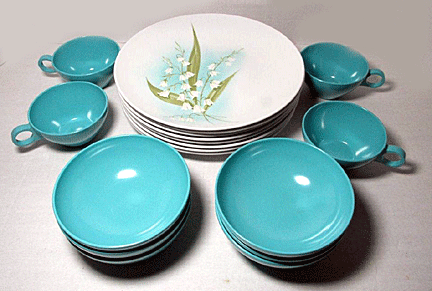 Prolon
is only one of the many great lines produced by the Prophylactic Brush
Company in Florence MA. The Florence and Beverly lines were perhaps the
most popular for residential use, though today we seem to find more of
the restaurant ware, both mottled and solid colors. Prolon
is only one of the many great lines produced by the Prophylactic Brush
Company in Florence MA. The Florence and Beverly lines were perhaps the
most popular for residential use, though today we seem to find more of
the restaurant ware, both mottled and solid colors.
The Plastics Manufacturing Company of Dallas, Texas, produced Texas
Ware, Dallas Ware, Oblique, SRO and Elan. The Boonton Molding Company of
Boonton, New Jersey, offered Boontonware, Patrician and Somerset.
International Molded Products in Cleveland, Ohio, produced Brookpark/Arrowhead
Modern Design and Desert Flower lines designed by Joan Luntz. And the
Prophylactic Brush Company of Florence, Massachusetts, made Prolon. Its
Florence and Beverly lines were the most popular for home use.
Uses of Melmac
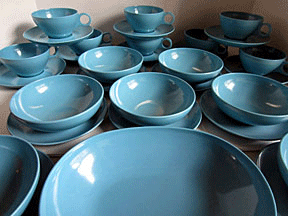 During
the late 1950s and 1960s Melmac dinnerware found its way into just about
every American home. However, the tendency of melamine cups and plates
to stain and scratch led sales to decline in the late 1960s, and
eventually it became largely limited to the camping and nursery markets. During
the late 1950s and 1960s Melmac dinnerware found its way into just about
every American home. However, the tendency of melamine cups and plates
to stain and scratch led sales to decline in the late 1960s, and
eventually it became largely limited to the camping and nursery markets.
One of the main attributes of Melmac is its durability. The lightweight
plastic construction holds up very well, although the surface of Melmac
dishes do tend to scratch with relative ease. Households with children
found Melmac to be ideal for use at informal family dinners as well as
with cookouts in the back yard.
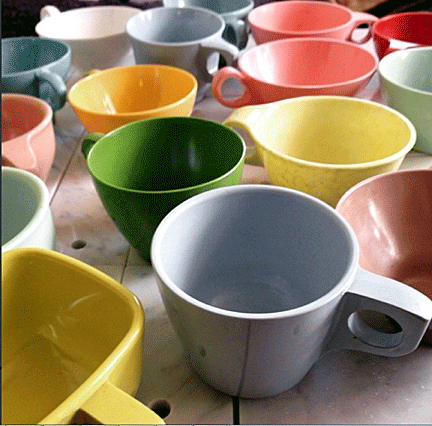 Manufacturers
used Melmac for just about any type of dinnerware, including plates,
cups and saucers, serving pieces, and glasses. Manufacturers could add
any type of color pigment to the resin during the molding process. As a
result, they created it in a variety of colors and patterns. Muted
colors, such as pea green and seafoam appeared in the late 1950’s, and
during the late 1960s, makers experimented with interesting color
combinations to complement the psychedelic look of the time. Manufacturers
used Melmac for just about any type of dinnerware, including plates,
cups and saucers, serving pieces, and glasses. Manufacturers could add
any type of color pigment to the resin during the molding process. As a
result, they created it in a variety of colors and patterns. Muted
colors, such as pea green and seafoam appeared in the late 1950’s, and
during the late 1960s, makers experimented with interesting color
combinations to complement the psychedelic look of the time.
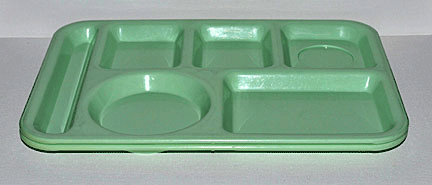 Along
with Melmac’s use in the home, schools used it for trays in their
cafeterias. Utilizing a round or rectangular design, Melmac trays were
often divided into sections that made it possible to easily place each
entrée, vegetable, and dessert into place while going through the line.
Many designs even included a slot that was ideal for the placement of a
half-pint of milk or a coffee cup. Along
with Melmac’s use in the home, schools used it for trays in their
cafeterias. Utilizing a round or rectangular design, Melmac trays were
often divided into sections that made it possible to easily place each
entrée, vegetable, and dessert into place while going through the line.
Many designs even included a slot that was ideal for the placement of a
half-pint of milk or a coffee cup.
But by the end of the 1970s, Melmac had declined in popularity.
Today, collectors can find vintage Melmac in thrift stores, at estate
sales, online auction sites, and garage sales. It's fun to collect it
and due to it's long production, it’s easy to make a whole set. Some
Melmac pieces are worth more in value than others. Full sets in pinks or
blues are generally priced higher. Though you may have a problem finding
full sets, you can start collecting it inexpensively by piecing sets
together.
<
Back to More Antique Spotlights
Next
Article >
|
